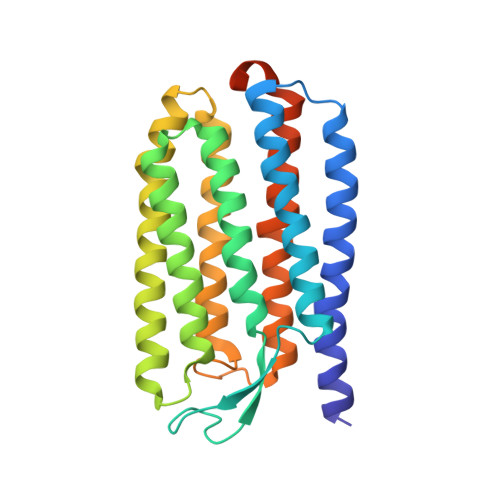Crystal Structure of Halobacterium Salinarum Halorhodopsin with Partially Depopulated Primary Chloride Binding Site
Schreiner, M., Schlesinger, R., Heberle, J., Niemann, H.H.(2016) Acta Crystallogr Sect F Struct Biol Cryst Commun 72: 692
- PubMed: 27599860
- DOI: https://doi.org/10.1107/S2053230X16012796
- Primary Citation of Related Structures:
5G36 - PubMed Abstract:
The transmembrane pump halorhodopsin in halophilic archaea translocates chloride ions from the extracellular to the cytoplasmic side upon illumination. In the ground state a tightly bound chloride ion occupies the primary chloride-binding site (CBS I) close to the protonated Schiff base that links the retinal chromophore to the protein. The light-triggered trans-cis isomerization of retinal causes structural changes in the protein associated with movement of the chloride ion. In reverse, chemical depletion of CBS I in Natronomonas pharaonis halorhodopsin (NpHR) through deprotonation of the Schiff base results in conformational changes of the protein: a state thought to mimic late stages of the photocycle. Here, crystals of Halobacterium salinarum halorhodopsin (HsHR) were soaked at high pH to provoke deprotonation of the Schiff base and loss of chloride. The crystals changed colour from purple to yellow and the occupancy of CBS I was reduced from 1 to about 0.5. In contrast to NpHR, this chloride depletion did not cause substantial conformational changes in the protein. Nevertheless, two observations indicate that chloride depletion could eventually result in structural changes similar to those found in NpHR. Firstly, the partially chloride-depleted form of HsHR has increased normalized B factors in the region of helix C that is close to CBS I and changes its conformation in NpHR. Secondly, prolonged soaking of HsHR crystals at high pH resulted in loss of diffraction. In conclusion, the conformation of the chloride-free protein may not be compatible with this crystal form of HsHR despite a packing arrangement that hardly restrains helices E and F that presumably move during ion transport.
Organizational Affiliation:
Department of Chemistry, Bielefeld University, Universitätsstrasse 25, 33615 Bielefeld, Germany.

















